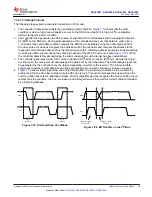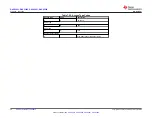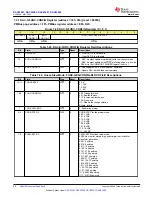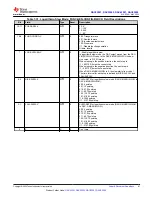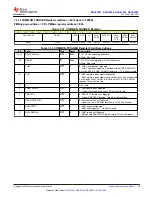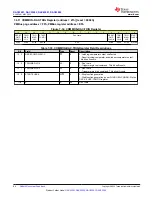
7.5.2.2 I
2
C Update Sequence
shows that for a single update, the DACx300x require a start condition, a valid I
2
C address byte, a
command byte, and two data bytes.
Table 7-14. Update Sequence
MSB
....
LSB
ACK
MSB
...
LSB
ACK
MSB
...
LSB
ACK
MSB
...
LSB
ACK
Address (A) byte
Command byte
Data byte - MSDB
Data byte - LSDB
DB [31:24]
DB [23:16]
DB [15:8]
DB [7:0]
shows that after each byte is received, the DACx300x family acknowledges the byte by pulling the
SDA line low during the high period of a single clock pulse. These four bytes and acknowledge cycles make up
the 36 clock cycles required for a single update to occur. A valid I
2
C address byte selects the DACx300x.
1
7
8
9
1
2 - 8
9
S
or
Sr
SDA
SCL
MSB
Address
START or
REPEATED
START
condition
Recognize
START or
REPEATED
START
condition
R/W
ACK
Acknowledgement
signal from target
Generate ACKNOWLEDGE
signal
Sr
or
P
P
Sr
REPEATED
START or
STOP
condition
Recognize
STOP or
REPEATED
START
condition
ACK
Figure 7-21. I
2
C Bus Protocol
The command byte sets the operating mode of the selected DACx300x device. For a data update to occur
when the operating mode is selected by this byte, the DACx300x device must receive two data bytes: the most
significant data byte (MSDB) and least significant data byte (LSDB). The DACx300x device performs an update
on the falling edge of the acknowledge signal that follows the LSDB.
When using fast mode (clock = 400 kHz), the maximum DAC update rate is limited to 10 kSPS. Using fast mode
plus (clock = 1 MHz), the maximum DAC update rate is limited to 25 kSPS. When a stop condition is received,
the DACx300x device releases the I
2
C bus and awaits a new start condition.
DAC53001, DAC53002, DAC63001, DAC63002
SLASF48 – MAY 2022
50
Copyright © 2022 Texas Instruments Incorporated
Product Folder Links:














